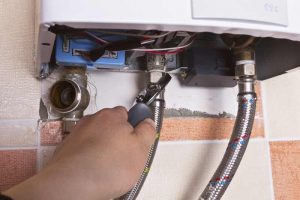
5 Winter Water Heater Maintenance Tips for the Brisk Weather
Days are getting shorter and nights are getting colder. There's no denying it, winter is on its way. With that in mind, we prepared these 5 quick and easy tips to keep your water heater in good health and to save you money on your energy bills through the coming months.
1. Testing the TPR Valve
As its name suggests, the TPR or Temperature/Pressure Relief valve is designed to release pressure if it gets too elevated inside the tank to avoid damage or injury. To check it, place a bucket under the drainpipe and open the valve.
 If only a trickle or no water comes out at all, or if it continues to run after the valve is closed, you should replace it. Drain a few gallons from the tank (see the ‘Flushing the Tank’ section below for instructions) and remove the defective valve with a wrench. Wrap Teflon tape around the threads of your new valve before installing it.
If only a trickle or no water comes out at all, or if it continues to run after the valve is closed, you should replace it. Drain a few gallons from the tank (see the ‘Flushing the Tank’ section below for instructions) and remove the defective valve with a wrench. Wrap Teflon tape around the threads of your new valve before installing it.
2. Checking the Anode Rod
The anode rod, made of aluminum or magnesium, is suspended inside the tank to slow the progress of rust on the metal lining by attracting water’s corrosive elements and rusting first. Once it is corroded, it no longer provides any protection.
 Drain a few gallons from the tank and locate the hexagonal rod head on top of the heater. Loosen it with a 1 1/16” socket and pull it out to look at it. If it has rusted down to less than ½” in diameter, a new one is needed.
Drain a few gallons from the tank and locate the hexagonal rod head on top of the heater. Loosen it with a 1 1/16” socket and pull it out to look at it. If it has rusted down to less than ½” in diameter, a new one is needed.
Here too, you'll want to wrap Teflon tape around the replacement rod before securing it tightly in the tank.
3. Flushing the Tank
One of the greatest culprits that rob your water heater of its energy efficiency is the accumulation of sediment that settles to the bottom of the tank over time. You can clean it out by completely emptying the tank. Attach a garden hose to the drain valve located near the bottom of your heater and place the other end where the water can empty safely. Open the valve to empty the tank. Once the tank is empty, open the cold water supply valve for a few minutes to clear out any remaining sediment.
You can now refill the tank, making sure that the drain valve is closed. Once the tank is partially filled, turn the heater back on.
4. Checking the Temperature Setting
 You may be tempted to turn the thermostat up higher on your water heater during the colder winter months. To conserve energy and prevent accidental scalding, we recommend setting it to 120°F. For every 10° lower on your thermostat, you could achieve up to 5% savings on your energy bills.
You may be tempted to turn the thermostat up higher on your water heater during the colder winter months. To conserve energy and prevent accidental scalding, we recommend setting it to 120°F. For every 10° lower on your thermostat, you could achieve up to 5% savings on your energy bills.
5. Insulating Your Water Heating System
For added energy and cost savings, you can wrap your hot water tank with an insulating foil blanket that prevents heat loss. Cut around all the pipes, valves, and thermostat and seal the blanket tightly with foil tape. You can prevent further heat loss through the pipes by sliding some 3/8” self-adhesive pipe insulation onto as much of it as you can reach and peeling off the tape to create a seal.
If you'd like some assistance with your water heater maintenance or for any repairs or service, feel free to contact the Sun Prairie, WI experts at Oliver's Plumbing by calling 608-834-8767.


